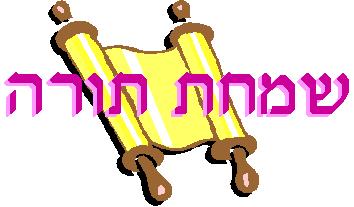

The Torah instructs us to keep the eighth day after Sukkot as a holy day. It is called Shemini Atzeret (the eighth day of gathering) but there are few specific rituals or meaning associated with it other than the cessation of work. On the eighth day you shall hold a solemn gathering; you shall not work at your occupations. [Numbers 29:35] While the rabbis suggested that this day was intended to prolong Sukkot, so people could remain in Jerusalem an extra day before returning home, the truth is we know little about the meaning of this day. It seems to me that Shemini Atzeret is the official conclusion to the Sukkot "season" in much the same way that Shavuot is the conclusion to the Pesach season in the spring.
The cycle of reading the Torah began anew on the Shabbat following Shemini Atzeret in some, but not all, locations. The reading cycle developed over a long period of time, and was not solidified until the early Middle Ages. Hence the day after Shemini Atzeret came to be celebrated as the time to begin the cycle again. Where two days of the festival are observed, the eighth day of Sukkot remains Shemini Atzeret alone and Simchat Torah is celebrated on the following day. In Israel and in the Reform Movement, Simchat Torah is celebrated on the eighth day following Sukkot and Shemini Atzeret and Simchat Torah are combined.
Hence Simchat Torah, which means "Rejoicing in the Torah" is a celebration of the renewal of the yearly cycle of reading. As mentioned, this cycle developed over time. Today, the Torah is divided into 54 portions, one assigned to each week, except when a festival falls on Shabbat. On Simchat Torah we finish the reading cycle of the previous year and then immediately start anew, reading from the first parshah of Genesis, signifying that for us Torah study never ends.
Torah is the constitution and backbone of Judaism. While there are other texts we hold sacred and which inform our rituals and values on a day-to-day basis (see Jewish Holy Texts) it is the Torah which serves as the foundation and binding force bringing Jews together. Our commitment to the Covenant of the Torah, although diversely interpreted, makes us one people. Torah is the source of our life as a people, and hence the cycle of reading, which brings us together as a community of learners and worshipers, is cause for great celebration.
It is customary to dance and sing with the Torah on Simchat Torah. Hakafot (circlings in the synagogue with the Torah) are joyous celebrations of the meaning of Torah in our lives. People sing and dance, children wave flags on which candied applies are mounted, and the community gives thanks for the blessing of the Torah. There are seven hakafot prior to the reading, each accompanied by a series of verses praising God and Torah, and songs chosen by the community to sing. Then two scrolls are brought to the bima and the closing passages of Deuteronomy are read, followed by the opening passage of Genesis.
Simchat Torah is the one time during the year when young children (under 13) are permitted an aliyah (to blessing the Torah before the congregation). They are ushered together as a group and a tallit is spread over their heads as they together recited the berakhah (blessing) accompanied by an adult.
The Jewish Holidays: A Guide & Commentary by Michael Strassfeld (Harper & Row).
The How To Handbook for Jewish Living by Kerry M. Olitzky and Ronald H. Isaacs (Ktav).
It's a Mitzvah! by Bradley Shavit Artson (Behrman House and the Rabbinical Assembly).
Jewish Family & Life by Yosef I. Abramowitz and Rabbi Susan Silverman (Golden Books).
The Kid's Catalog of Jewish Holidays by David Adler (Jewish Publication Society).
Seasons for Celebration by Rabbi Karen L. Fox and Phyllis Zimbler Miller (Perigee Books).